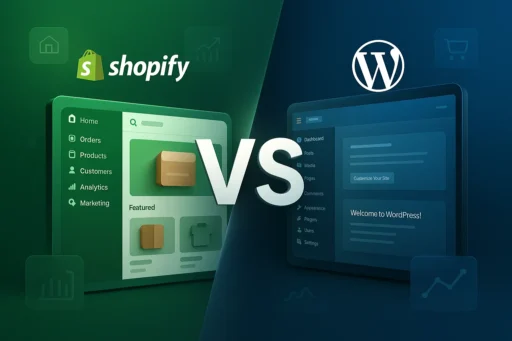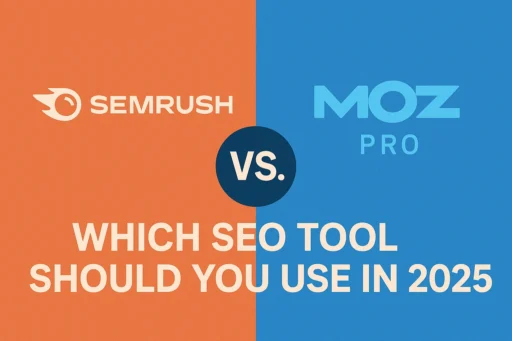Shopify and WordPress represent two powerful paths to building your online store in 2025. At Search Savvy, we understand that choosing the right ecommerce platform can make or break your digital business. This comprehensive guide examines both platforms to help you make an informed decision that aligns with your business goals, budget, and technical expertise.
What is the Main Difference Between Shopify and WordPress for Online Stores?
Shopify is a dedicated ecommerce platform designed specifically for online selling, offering an all-in-one solution with built-in hosting, security, and sales features. WordPress, on the other hand, is a content management system that requires the WooCommerce plugin to add ecommerce functionality, providing greater flexibility but demanding more technical knowledge.
Online store owners need to understand this fundamental distinction. Shopify operates as a closed-source hosted platform where everything is managed externally, while WordPress functions as an open-source self-hosted solution where you control every aspect of your website. Search Savvy has observed that this core difference influences every other aspect of your online store experience-from setup time to long-term scalability.
How Does Shopify Pricing Work in 2025?
Shopify pricing in 2025 follows a tiered subscription model with four main plans, each designed to accommodate different business sizes. The platform starts with a Starter plan at $5/month for social selling, progresses to Basic at $39/month, Grow (formerly called “Shopify”) at $105/month, and Advanced at $399/month. New users can try any plan for just $1 for the first three months after a three-day free trial.
Online store owners benefit from knowing exactly what they’ll pay each month. The Basic plan includes hosting, SSL certificate, unlimited products, abandoned cart recovery, and 24/7 support. Transaction fees decrease as you move up the pricing tiers-from 2% on Basic to 0.6% on Advanced when using third-party payment gateways. Shopify Payments eliminates these extra fees, charging credit card rates from 2.9% + 30¢ on Basic down to 2.4% + 30¢ on Advanced plans.
Shopify also offers enterprise-level Shopify Plus starting at $2,300/month for high-volume businesses requiring custom solutions, dedicated account managers, and lower transaction fees. According to Search Savvy’s research, businesses processing over $800,000 annually typically find Plus worthwhile due to the reduced fees and priority support.
What Are the Real Costs of Running a WordPress Online Store?
WordPress itself is free to download, but online store owners must budget for several essential components. Hosting typically costs $10-$40/month depending on your provider and plan, with options like SiteGround, Bluehost, or specialized WooCommerce hosting from WooExpress starting at $39/month. Domain names add another $10-$20 annually.
Online store setup requires the free WooCommerce plugin for ecommerce functionality, but additional costs accumulate quickly. Premium themes range from $20-$100 annually, while essential plugins for advanced features like subscriptions ($279/year), abandoned cart recovery ($79/year), or table rate shipping ($119/year) add to your investment. SSL certificates cost $8-$65/year unless included in your hosting package.
WordPress total annual costs typically range from $200 for basic stores to $1,500+ for larger operations with premium themes, multiple extensions, and robust hosting. At Search Savvy, we’ve found that WordPress can be more affordable initially but requires careful budgeting as your store grows and you add necessary functionality through paid plugins.
Why is Ease of Use Important in 2025?
Shopify excels in user-friendliness with its intuitive dashboard and comprehensive setup wizard that guides you through choosing themes, adding products, and configuring shipping and payments. The platform allows business owners to launch professional online stores within hours, even without technical experience. Everything operates from a single dashboard-product management, order processing, customer data, and analytics all in one place.
WordPress requires more technical proficiency. Online store owners must first purchase hosting, install WordPress through their provider, learn the WordPress interface, and then install WooCommerce plus additional plugins for full ecommerce functionality. Store management splits between the WordPress dashboard and WooCommerce plugin interface, creating a steeper learning curve compared to Shopify’s unified experience.
According to Search Savvy experts, beginners typically find Shopify 70% faster to set up than WordPress. However, WordPress rewards the extra effort with greater customization control-you can modify virtually anything if you have the technical skills or budget to hire developers.
How Do Sales Features Compare Between Platforms?
Shopify includes robust built-in sales features designed specifically for ecommerce. Online store owners get unlimited products, abandoned cart recovery, discount codes, gift cards, and multi-channel selling across Instagram, TikTok, Facebook, Amazon, and other platforms-all managed from one dashboard. The platform automatically syncs inventory across all sales channels and includes point-of-sale (POS) capabilities for in-person selling.
WordPress through WooCommerce offers similar core functionality but requires downloading and configuring separate plugins. Online store functionality depends entirely on which plugins you choose and how well they integrate. WooCommerce provides basic features for free, including product listings, basic shipping calculations, and standard reports. Advanced features like subscriptions, memberships, bookings, or sophisticated inventory management require premium extensions.
Shopify’s winter 2025 update introduced low inventory cart warnings and attribute-based collections (organizing products by color, material, etc.), making inventory management even more intuitive. Online store scalability is notably easier on Shopify, which handles high traffic seamlessly, whereas WordPress performance depends heavily on your hosting quality and optimization efforts.
What About Design Flexibility and Themes?
WordPress dominates in design flexibility with thousands of free themes in its directory and virtually unlimited customization potential. Online store owners with coding knowledge can modify every pixel of their website. Even without coding skills, WordPress’s advanced editor provides granular control over layout and design elements. Premium themes offer sophisticated designs starting at $20-$100 per year.
Shopify offers over 140 themes (mostly premium at $150-$350), with designs optimized specifically for ecommerce. Online store templates are clean, mobile-responsive, and ready to launch with minimal customization. While less flexible than WordPress, Shopify themes are specifically engineered for conversion optimization and fast loading times-crucial factors for ecommerce success.
Search Savvy recommends WordPress for businesses where brand identity and unique design are paramount, while Shopify suits those who want professional, conversion-focused designs without extensive customization work.
How Does Security and Maintenance Differ?
Shopify handles all security and maintenance automatically. Online store owners receive Level 1 PCI DSS compliance certification, automatic updates without downtime, free SSL certificates, and enterprise-grade DDoS protection. The platform manages everything behind the scenes, ensuring your store remains secure and up-to-date without any action required on your part.
WordPress requires active security management. Online store owners must manually update WordPress core, themes, and plugins to patch vulnerabilities-a critical task since outdated plugins are the #1 security risk for WordPress sites. Updates often trigger maintenance mode, temporarily blocking customer access. You’ll need security plugins like Sucuri ($0-$200/year) or Jetpack for malware scanning, firewalls, and brute force protection.
Why is Customer Support Critical for Your Online Store?
Shopify provides 24/7 support via live chat, email, and phone across all plans. Online store owners on Shopify Plus receive dedicated account managers and priority support. The platform also offers extensive documentation, video tutorials, and an active community forum. Response times are typically under 5 minutes for chat support.
WordPress support varies significantly based on your hosting provider and plugin choices. Online store owners get ticket-based email support from WordPress.org forums, while hosting providers offer varying support levels. WooCommerce provides community forums and documentation but no direct support unless you purchase specific extensions. Premium plugins include their own support, creating a fragmented support experience.
Which Platform is Better for International Selling?
Shopify excels at international ecommerce with built-in tools for multi-currency pricing, automatic tax calculations, country-specific product availability, and localized checkout experiences. Online store owners can manage up to 50 markets and set custom prices per region. The Managed Markets feature even handles merchant-of-record responsibilities for certain countries.
WordPress with WooCommerce requires plugins for international features. Online store owners need additional extensions for multi-currency support, geolocation, tax calculations, and translated content. While more complex to set up, WordPress offers unlimited language options and complete control over international pricing strategies through plugins like WPML and WooCommerce Multilingual.
How Do Payment Processing Fees Affect Your Bottom Line?
Shopify Payments (the platform’s native processor) charges 2.5-2.9% + 30¢ per online transaction and 2.4-2.6% + 10¢ for in-person transactions, depending on your plan. Online store owners using third-party gateways like PayPal or Stripe pay additional transaction fees: 2% on Basic, 1% on Grow, and 0.6% on Advanced. Currency conversion adds 1.5% for international transactions.
WordPress through WooCommerce lets you choose any payment processor. Online store owners commonly use WooPayments (2.9% + 30¢ with no additional platform fees), Stripe (2.9% + 30¢), or PayPal (similar rates). There are no platform transaction fees-you only pay your chosen processor’s rates, potentially saving significant money on high-volume sales compared to Shopify’s third-party gateway fees.
What Integration and App Ecosystem Options Exist?
Shopify’s App Store contains over 8,000 apps covering email marketing, inventory management, dropshipping, product reviews, SEO tools, and more. Online store owners can add functionality with one-click installations, though premium apps typically cost $5-$70/month each. Apps are specifically designed for Shopify, ensuring compatibility and streamlined integration.
WordPress offers 60,000+ plugins for virtually any functionality imaginable. Online store owners enjoy unprecedented flexibility in building custom solutions. Many essential plugins are free, though premium options range from one-time purchases of $50-$200 to recurring subscriptions. The vast selection means you’ll almost certainly find plugins for your specific needs, but compatibility issues between plugins can create technical challenges.
At Search Savvy, we’ve observed that Shopify’s curated app ecosystem trades some flexibility for reliability, while WordPress’s open ecosystem offers maximum flexibility but requires more technical oversight to ensure everything works together harmoniously.
Which Platform Offers Better SEO Capabilities?
WordPress was built with content management in mind, making it inherently SEO-friendly. Online store owners have complete control over URL structures, meta tags, schema markup, and site architecture. Plugins like Yoast SEO and Rank Math provide comprehensive SEO optimization tools. WordPress’s blogging capabilities are unmatched, letting you create content strategies that drive organic traffic.
Shopify includes solid SEO foundations with editable meta tags, customizable URLs, automatic sitemap generation, and mobile-responsive themes. Online store owners can create blog content, though not with WordPress’s sophistication. Shopify’s structure is optimized for ecommerce but offers less granular SEO control than WordPress. Recent Shopify updates have improved SEO capabilities, narrowing the gap.
How Does Each Platform Handle Scalability?
Shopify scales effortlessly from small startups to enterprise operations processing millions in monthly revenue. Online store owners never worry about server capacity, bandwidth limitations, or traffic spikes-Shopify’s infrastructure handles it automatically. Upgrading plans takes seconds and doesn’t require site migration. Shopify Plus supports brands like Gymshark and Kylie Cosmetics, proving its enterprise credentials.
WordPress scalability depends entirely on your hosting infrastructure. Online store owners on shared hosting may experience slowdowns during traffic surges, requiring upgrades to VPS ($20-$100/month) or dedicated hosting ($100+/month). Larger stores often invest in content delivery networks (CDNs) and advanced caching solutions. With proper investment in infrastructure, WordPress can scale to massive operations, but requires active management.
What Are the Migration Possibilities?
Shopify offers the Store Importer app that facilitates migration from WordPress/WooCommerce to Shopify, transferring products, customers, and order history. Online store owners can typically complete migrations in days. Moving from Shopify to WordPress requires third-party services or manual export/import processes.
WordPress to Shopify migrations are relatively straightforward, while moving between WordPress hosting providers is even easier-you simply migrate your files and database. Online store flexibility is WordPress’s advantage here; you’re never locked into a specific provider or platform ecosystem.
Which Platform is Best for Specific Business Types?
Choose Shopify if you:
- Want to launch quickly without technical knowledge
- Prioritize convenience and comprehensive support
- Sell primarily products (physical or digital)
- Need multi-channel selling (social media, marketplaces)
- Want predictable monthly costs
- Value security and automatic updates
- Plan to scale rapidly
Choose WordPress if you:
- Have technical skills or budget for developers
- Need maximum design customization
- Want content-heavy sites with ecommerce components
- Require specific plugins unavailable on Shopify
- Prefer lower ongoing costs (especially initially)
- Need complete control over your platform
- Want to avoid vendor lock-in
Search Savvy’s Final Recommendation
At Search Savvy, we recommend Shopify for most online stores in 2025, particularly those focused primarily on selling products. Its streamlined approach, built-in features, and exceptional support justify the higher monthly costs for businesses prioritizing growth and convenience over maximum customization.
WordPress remains the superior choice for content-driven businesses, those requiring extensive customization, or entrepreneurs with technical expertise who want complete control over their platform. The initial cost savings and unlimited flexibility make WordPress compelling for certain use cases, but require more hands-on management.
Online store success ultimately depends less on platform choice and more on your products, marketing, and customer service. Both platforms power highly successful businesses-the key is choosing the one that aligns with your specific needs, skills, and resources.
Frequently Asked Questions
Q: Can I use both Shopify and WordPress together?
A: Yes! You can add the Shopify Buy Button to your WordPress site, allowing you to sell products through Shopify while maintaining your WordPress site for content. This hybrid approach gives you WordPress’s content management strengths with Shopify’s ecommerce capabilities.
Q: Which platform is cheaper in the long run?
A: WordPress typically costs less initially ($200-$600/year for basic stores) compared to Shopify’s minimum $468/year on the Basic plan. However, as you add premium themes, plugins, and better hosting, WordPress costs can exceed Shopify’s all-inclusive pricing. For high-volume stores, Shopify’s transaction fees may make WordPress more economical.
Q: Do I need coding skills for either platform?
A: Shopify requires zero coding knowledge-you can build a fully functional store using drag-and-drop tools and settings. WordPress doesn’t strictly require coding but understanding HTML/CSS helps significantly for customization. Many WordPress store owners hire developers for advanced modifications, while Shopify users rarely need developer assistance.
Q: Which platform is better for dropshipping?
A: Shopify generally works better for dropshipping due to its extensive app integrations with suppliers like Oberlo, Spocket, and DSers. Setup is faster and inventory management more straightforward. WordPress can handle dropshipping through WooCommerce plugins, but requires more configuration and technical oversight.
Q: Can I switch platforms after launching my store?
A: Yes, though migration involves work. Moving from WordPress to Shopify is relatively straightforward using migration apps that transfer products, customers, and orders. Moving from Shopify to WordPress requires manual export/import or professional migration services. Plan your platform choice carefully to avoid migration headaches later.
Q: Which platform has better loading speeds?
A: Shopify typically delivers faster loading speeds out-of-the-box because it controls the entire hosting infrastructure and optimizes specifically for ecommerce. WordPress speeds depend on your hosting quality, theme optimization, and plugin efficiency-a well-optimized WordPress site can match or exceed Shopify speeds, but requires active optimization work.







